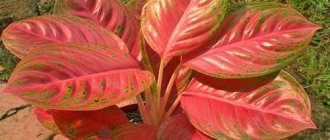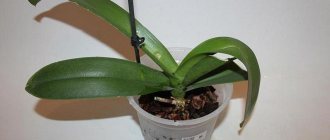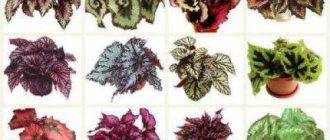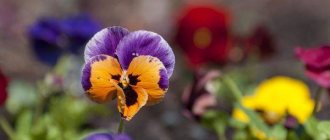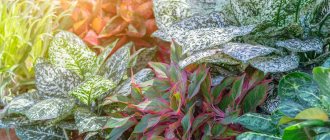Aglaonema is a herbaceous plant from the Araceae family. In nature, representatives of this genus are found in Southeast Asia and the Malay Archipelago. Translated from Greek, the name of the culture is translated as aglaia (shine) and nema (stamen). In natural conditions, it prefers humid plains, tropical forests, and river banks.
Aglaonema is a close relative of Dieffenbachia. It differs only in narrower leaves and smaller sizes. Although aglaonema is not yet often seen as a houseplant, it is considered one of the most suitable for hydroponic growing. In addition, it is able to absorb toxic substances that fill the surrounding air, purifying it.
Types and varieties for growing at home
The genus Aglaonem, according to average estimates, consists of 20-50 species. These are herbaceous crops with erect stems. Some varieties have branched stems. The leaf blades are dense and leathery. Their shape can be different - from ovoid to oblong-lanceolate. On the bottom of the leaf, a depressed vein protrudes in the middle. The color of the leaves may vary depending on the variety. Only some types of aglaonema, mainly hybrid ones, are suitable for home cultivation.
Changeable (commutatum)
The plant is about 0.5-0.7 m high and comes from the Philippines. The leaves are green, covered with silver-beige spots. They can reach 30 cm in length and 10 cm in width.
Popular varieties:
- Silver,
- Queen,
- Maria.
Painted (pictum)
The culture comes from the islands of Borneo and Sumatra, about 60 cm high. The stem is branched. It has large elongated leaves in the shape of an ellipse. There are irregular light grayish spots on the surface.
Popular varieties:
- Silver King,
- Pattaya Beauty,
- Treuba.
Hybrid Valentine has pink-green variegated leaves.
Moderate or modest (modestum)
In the wild it grows on the mountain slopes of the tropical forests of Indochina and the Malay Archipelago. The stems are branched, about 40-50 cm high. The leaf blades are oval, pointed towards the apex, and have several protruding veins on the side of the central vein.
Shiny (nitidum)
The plant is about 1 m high, common in Thailand, Sumatra and Kalimantan. The leaves are bright green, about 0.45 m long, with a shiny, glossy surface.
Ribbed (costatum)
Low-growing herbaceous shrub with branched stems at the base. The leaves are ovoid, 20 cm long and 10 cm wide. Their structure is dense, green in color with white spots on the surface.
Curly (roebelinii)
Shrub with strongly branching stems. The leaves are elliptical, about 30 cm long. The surface is silvery-gray.
Today, with the help of selection, more and more new varieties are being developed that have a variety of leaf colors.
Where is this beauty from?
Aglaonema is native to the tropical forests of India. But it came to German Europe from China, judging by the English name: Chinesse evergreen (“Chinese evergreen”). Simple. However, the question arises: are there other evergreen plants in England?
By the time the British got there, the Chinese had been growing aglaonema in their gardens for centuries.
It has been bred for a very long time in Southeast Asia: in Indonesia, Thailand, the Philippines and Vietnam. New varieties and hybrids are also bred there. That's where they are brought from.
Home care
Aglaonema's natural habitat is the tropics. Therefore, to grow indoors, the plant needs to be provided with warmth, high humidity and other suitable conditions.
Location and lighting
It is best to purchase the crop in the store in spring or summer. During this period, aglaonema tolerates a change of environment more easily and quickly adapts to a new place of residence. It is advisable to choose young seedlings for cultivation.
It is important to immediately determine the place where the flowerpot will stand. Partial shade is preferable for him. The plant is shade-tolerant and does not react well to the scorching sun. But some aglaonemas need diffused light so that their leaves do not lose their decorative effect. To understand exactly how much light a plant needs, you need to focus on the colors of the leaves. If they are dark green, it is better to place the flowerpot in partial shade. Leaves with variegated colors require more light.
Choosing a flowerpot
The container for planting the crop must match its size. It is recommended to take a flowerpot that will be a little cramped for the aglaonema. If there is too much space around, the plant will grow roots. As a result, the crown will develop slowly, and splendor will have to wait a long time.
It is better to give preference to clay and ceramic pots. They have good air permeability and do not retain moisture. Also, such containers are heavier than plastic ones. The flowerpot will not overturn under the weight of the stems.
Soil and drainage
Aglaonema requires soil that can drain moisture and air well. You can buy ready-made substrate for violets or azaleas. If you prepare the mixture yourself, you need to take 2 parts of leaf soil, 1 part each of peat and sand. The crop grows well in hydroponics - growing without soil in a nutrient solution.
There must be drainage at the bottom of the pot (expanded clay, broken brick). It will help avoid stagnation of water in the soil.
Planting and transplanting
Young aglaonemas grow quickly. Therefore, it is recommended to transplant them into a new container once a year, preferably in the spring. Adult specimens need transplants less often - once every 3-4 years. But every year they need to renew the top layer of soil, replacing it with more nutritious soil.
Transplant procedure:
- Pour a 2-3 cm thick layer of drainage into the pot. Fill it halfway with soil.
- Water the plant well and remove it from the old pot.
- Place the aglaonema in the center of the new container, carefully straighten the roots, and shake the soil.
- Fill the pot with soil up to the root neck. Do not let soil get on the sockets.
- Moisten the soil and place the pot in a semi-shaded place or under diffused lighting.
Step-by-step visual video - instructions for transplanting aglaonema:
Temperature
During the active growing season, the plant should be kept at a temperature of +20-25 degrees.
In winter it can be lowered to +16..18°C. Warning! Sudden temperature changes and drafts should not be allowed. Aglaonema can die from this.
Watering and humidity
In the warm season, when active growth is underway, the plant needs to be watered daily. But do not over-moisten the soil to avoid rotting of the root system. In autumn and winter, watering is reduced. The top layer of the substrate must dry out. Use soft warm water +27-30 degrees.
Aglaneoma needs high humidity. To maintain it, in summer the leaves are sprayed daily with a spray bottle. In winter, if the temperature is low, spraying is carried out sparingly. You can increase the humidity by placing the flowerpot on a tray with wet expanded clay or sphagnum. Sometimes you can bathe the plant under a warm shower.
Feeding and fertilizers
The crop needs to be fed from March to October. It is recommended to alternate the use of mineral and organic fertilizers. The frequency of feeding is once every 2 weeks. Compositions with a high nitrogen content are more suitable for the development of green mass. Lime fertilizers are best avoided. In cloudy weather, in addition to applying to the soil, you can use spraying with weak fertilizer solutions.
Good feeding:
- Agricola;
- Fantasy;
- Effecton.
When the autumn cold sets in outside, you should stop feeding and give the plant a rest.
Flowering and dormant period
In indoor conditions, aglaneoma blooms very rarely. This happens in June-August. Inflorescences form in the axils of the leaves. These are cobs wrapped in a petal that resembles a blanket. The cob can be of different shapes and lengths, depending on the type of crop. After flowering, white, red or orange fruits appear, similar to dogwood, which are very poisonous.
In winter, the plant needs rest. All processes slow down. From October to February, you should stop feeding, reduce watering, and move the flowerpot to a cooler place.
Trimming
In spring or early summer it is recommended to rejuvenate the bush. Pruning is carried out when the plant sheds its lower leaves. It is necessary to remove the upper segments and treat the cut areas with activated carbon. This procedure promotes the formation of young shoots. Trimmings can be used to propagate aglaonema.
Biological description
The decorative effect of the plant is provided primarily by its leaves. They are quite wide and long. Some leaves may have interesting textured colors or structural features of the edges.
Aglaonema moderate in a driftwood pot
The variety of varieties and varieties of aglaonema allows the plant to be used in a wide variety of design solutions . This is an unpretentious and low-maintenance plant that even a person with very little botanical knowledge can handle.
Aglaonema is an evergreen herb or subshrub from the broad group of Araceae . Almost all Aroids are representatives of the Equatorial climate, however, our beauty comes from East Asia, more precisely from India. There are also wild species of Aglaonema in Malaysia and the Philippines.
In total, there are about 50 species of this plant , however, due to the commonality of some of its representatives, which have characteristic properties in common with other members of the family, some botanists accept the number of species as 23.
Such confusion in classification often leads to the fact that even within one relatively small subfamily, not every botanist can accurately differentiate one species or another. On the other hand, this is wonderful in its own way, since you can always say that you have a unique flower of the Araceae family, which no one else in the world has!
Young plants
A feature of the plant is the virtually complete absence of a stem. The stem serves solely to form and maintain the flower. There are no foliage on the stem; it grows from the root without the participation of the stem on its own. However, in adult representatives a certain semblance of a stem can form - a short part of the growing season that has a noticeable thickening, different from the leaves.
Growth is relatively slow. No more than 5-6 leaves may appear on a flower in a year. This low growth rate is explained by the living conditions of the flower. In its natural habitat, Aglaonema is on the lowest tier, and is content with the “remnants” of light that reach it from higher competitors.
The flowering parts are collected in inflorescences, which, like all Araceae, are cobs; The inflorescence contains up to 9 flowers. Ears are formed in the axils of the leaves; their number can reach up to three pieces per leaf. An interesting fact is the dioeciousness of the flower. That is, the plant has separate male and female flowers, which will have to be taken into account when artificially pollinating it.
Aglaonema ribbed flower
Aglaonema fruits ripen within six months, and their cultivation makes sense. Reason one: aglaonema is one of the few plants capable of normal seed propagation at home. Reason two: the fruits of aglaonema are more decorative and much more attractive than its flowers.
Each “berry” formed in the cob contains only one seed, but taking into account the total number of cobs and seeds in each inflorescence, the number of seeds obtained from one bush can be from 50 to 100 pieces.
Aglaonema, especially rich in leaves, is theoretically capable of producing up to 200 seeds . Seed germination is very high, so there are usually no problems with seed propagation.
Fruits of Aglaonema modified
Unlike the same spathiphyllum and zamioculcas, the aglaonema flower does not have any artistic value. This, in fact, is not critical, since the main part of the plant that attracts a person is not its flowers, but its leaves.
The leaf blades of Aglaonema have an ellipsoidal shape. Sometimes they are elongated and have pointed ends. At the beginning of their life, almost all the leaves of the plant are round, but then their shape changes. The veins on both young and adult leaves are practically indistinguishable against the general background of the leaf.
The size of the leaves may vary not only from species to species, but also within each of them. The length of the leaves can be from 10 to 60 cm. The color can vary from classic green to green with white or yellow spots. There are leaves that are completely white, as well as leaves with large areas of purple-red pigment.
Leaves of Aglaonema siamese, which has purple leaves
The height of the flower can reach up to 150 cm, however, the vast majority of flower growers prefer bushes of medium height. Part of the reason is that taller plants have more brittle leaves, especially at the base of the petioles.
Reproduction methods
The culture can be propagated in several ways. Most often they use cuttings or dividing the bush, less often - propagation by seeds.
Cuttings
Cut a cutting from a well-developed stem at a height of 2-3 cm from the ground. Divide it into several parts about 5 cm long, remove the foliage. Deepen the cuttings halfway for rooting in a mixture of peat and sand (1:1). Cover the container with film. Keep at a temperature of +22-26 degrees. The cutting will take root within a few weeks.
You can place the shoot in water, after soaking it in a solution that stimulates root formation. When the cuttings take root, they are transplanted into separate pots in suitable soil. The lateral shoots must be removed.
Dividing the bush
Dividing the bush can be done during plant transplantation:
- Carefully remove the bush from the pot and shake off the soil.
- Remove dry and damaged parts of the root with a clean tool.
- Divide the plant or cut it vertically down through the roots.
- Treat the cut areas with ash.
- Transplant each division into a separate pot and water well.
Seeds
Aglaonema is a self-pollinating plant. You can collect the seeds yourself if you manage to wait for fruiting at home. Before planting, remove the seeds from the fruits, wash them and dry them. Deepen into moistened sphagnum moss by 1.5 cm. Cover the container with film and germinate the seeds at a temperature of +20-26°C. Shoots will appear in 3-4 weeks. Sometimes this happens later. Remove the film from time to time to ventilate and control the humidity of the substrate. After the formation of a leaf rosette, the seedlings can be planted in separate pots with suitable soil.
Exercise caution
When working with the indoor plant Aglaonema Variable, Mix or Red, as well as with other species, you must follow safety rules. When replanting, loosening and other activities carried out with the flower, you need to wear gloves on your hands. The fact is that the sap of the plant is very caustic and, if it gets on the skin, can leave a burn. Never rub your eyes after working with aglonema without washing your hands. Wash your hands up to the elbows well with soap as soon as you finish working with the plant.
This is an amazing and beautiful flower - aglaonema! Caring for it at home will only bring you joy if you follow the prescribed rules, because thanks to this the plant will be healthy and beautiful!
Features of seasonal care
Aglaonema goes through several development phases throughout the year. There are periods of active vegetation and dormancy. Based on this, seasonal care should be adjusted.
Spring-summer period:
- temperature +22-25 degrees;
- abundant watering;
- frequent spraying;
- feeding once every 2 weeks.
Autumn-winter period:
- temperature about 16-18 degrees;
- moderate watering;
- lack of fertilizing.
How often should a flower be replanted?
While the plant is young, it is replanted every spring. The soil should be mostly leafy. Tropical forests are deciduous.
To ensure that the soil retains moisture well, but is permeable to air, add a little sand and crushed coal to it.
Humus is added to enrich it with nutrients. Don't forget to place a layer of pebbles at the bottom of the pot.
In adulthood, the flower matures and its appearance changes. The color of the leaves changes tone. Some types of aglonema begin to resemble a bush or even a tree.
Many are not ready for such a transformation, expecting youthful beauty from the plant. You must be able to look at the flower with a different eye and provide it with the appropriate conditions.
The plant looks much more beautiful on the floor than on a stand. Remember only about pets and small children who might even think of tasting it. It's dangerous for them.
An adult plant is replanted every three years.
Care errors and their elimination
Frequently encountered problems when growing aglaonema and ways to solve them:
| Problem | Causes | Solution |
| Wrinkling and drying of leaves | Dry air, drafts, dense soil | Spray the plant more often, replant it in loose soil that allows moisture to pass through well. |
| Loss of foliage brightness | Lack of lighting, lack of nutrients | Move the flowerpot under diffused light, regularly fertilize during the growing season |
| Yellowing of lower leaves | Soil waterlogging, high pH | Water moderately so that the water does not stagnate in the pan, transplant into soil with suitable acidity |
| Wilting leaves | Cold air, drafts | Do not allow the room temperature to drop below +16 degrees, avoid drafts and sudden temperature changes |
Where does she belong?
The plant does not tolerate direct sunlight. Smoke, even light, is harmful to it, so you can’t keep it in the kitchen.
Drafts have a bad effect on it. But he needs fresh air.
Aglaonema loves warmth and moisture. Moreover, you need to humidify the air without flooding the soil. In nature, it grows well along the banks of rivers and streams, and loves islands. In the house, next to the flower, you can place a container of water. This plant looks very beautiful next to the aquarium.
It is important to keep her away from your pets. It could be dangerous for them. The juice of the plant is irritating to the mucous membranes. Young children are attracted to the plant's bright red or orange fruits. A child should not be allowed to rip them off.
You need to think about everything in advance so that you don’t have to move the flower from place to place. Aglaonema prefers consistency. But then a corner was chosen for him to live, and you brought it home.
Diseases and pests, control methods
Aglaonema, if agricultural practices are violated, can be susceptible to diseases and pest invasions. If the plant is watered abundantly and the room is cold enough, it may be affected by gray rot. To get rid of it, you should cut off all damaged parts. Transplant the plant into a new pot and increase the air temperature.
Aglaonema pests:
- mealybug;
- spider mite
The vital activity of insects leads to gradual withering of the plant, drying out and falling of leaves, and cessation of growth. If action is not taken in time, it will die.
Effective pest control is only possible with the use of insecticides:
- Aktellik;
- Aktara;
- Intavir and others.
Feeding
Not the most capricious, but still demanding plant is aglaonema. Caring for it at home involves timely application of fertilizers. And here the “once every six months” option is not suitable; you need to fertilize correctly and consistently.
- As soon as the first spring sun appears on the street, and this happens from mid-March until the end, you need to start applying fertilizer.
- The first step is to feed the aglaonema with mineral fertilizers.
- After two weeks, apply nitrogen fertilizer.
- In another two weeks, organics.
You need to alternate this way until the end of September. But nitrogen fertilizers should subsequently be included in mineral fertilizers in small quantities. That is, mineral and organic fertilizers alternate.
As for winter and late autumn, during this period the plant will doze off, and it simply does not need extra feeding.
Aglaonema in the house: benefits and harm
This crop is grown at home for its decorative leaves. With proper care, aglaonema releases phytoncides. These are substances that help clean the air of toxic substances and pathogens. Feng Shui philosophy relates this culture to the element of Wood. It is recommended to keep it on the eastern side of the house to replenish vitality, increase efficiency, and combat stress.
But aglaonema also has negative sides. Like many Araceae, it contains poisonous sap. Therefore, if you handle the plant carelessly, you can get skin irritation. The fruits are especially poisonous. They are strictly forbidden to eat. You should be careful if there are children in the house who might accidentally eat the bright berries.
Aglaonema is an evergreen plant that, unfortunately, is not often found on the windowsills of houses. Thanks to its beautiful decorative foliage and simple care rules, the culture is gradually gaining popularity and becoming a favorite of flower growers.
Aglaonema is a wonderful plant both for a sunny windowsill and for the depths of a room. Grows well in artificial light. It is easy to care for, rarely requires replanting, and does not require spraying. More useful information about the features of growing crops can be found in the following video:
There is a choice
Aglaonema is a flower that amazes with its variety of species and varieties, here are the main ones:
- Aglaonema modest . The leaves are leathery, beautiful marsh color. The fruits resemble dogwoods. Very shade-tolerant even compared to its relatives. These plants are generally easy to care for. But this one is the most unpretentious.
- Painted . It can be more than half a meter tall. Dense, the trunk bushes strongly at the base. The fruits are red.
- Variety Crete . In one sheet it abundantly combines different colors, but mainly red. Some leaves grow entirely dark red. More demanding of light, otherwise the leaves lose color. The plant is a hybrid; its appearance may change with age.
In the photo are popular types of aglaonema
Lighting
The light is diffused, bright. The most suitable would be an east window, and in winter the plants can be placed on the south side.
Some varieties with variegated leaves require a little direct sunlight in the morning and evening so as not to lose the decorative color.
In summer and spring, plants need to be shaded from direct rays of the sun (they can lead to leaf burns).
Aglaonema is a shade-tolerant plant, so it can easily adapt to darkened places in distant areas of the room.
Red plant varieties require brighter lighting.
By the angle of inclination of the leaves (in relation to the stem) you can find out about the correct lighting. If the angle is from 45 to 90 degrees, the lighting is normal, lower readings indicate excess lighting.
Aglaneoma Silver Bay, Stripes, short-covered and rounded
Aglaneoma Silver Bay has an impressive size, growing more than one meter in height. It has an erect dark green trunk, which is not visible due to the dense foliage. It very slowly becomes bare from below, while the plant constantly branches from the roots. Therefore, Aglaonema Silver Bay retains its pomp and decorativeness for a long time. The attractiveness of this species is that it is cold-resistant.
The long leaves of the plant (up to thirty centimeters) are pointed towards the top. In the middle of the leaf blade there is a gray spot with jagged edges. The same small spots are located over the entire surface of the leaves. The main color of young leaves is light green; they darken as they grow.
Aglaonema Stripes. The decorative feature of Aglaonema Stripes lies in the light stripes that run from the center of the leaf to the edge. It gets along well in shaded rooms, for example, on north-facing windows.
Aglaonema short-covered. A variety with creeping or underground stems; only oval, highly elongated leaves with sharp tips are visible on the surface. They have a bright green color and a white vein in the center. In order for the plant to have a beautiful decorative appearance, you need to plant several seedlings in one container, since it produces few leaves and has slow growth.
Aglaonema is round. This species is considered one of the most beautiful of all Aglaonemas. On the underground stem, heart-shaped leaves of black and red color are formed, along which a pattern of bright pink stripes diverges.
Problems
Aglaonema fades - the air is not warm enough. It is necessary to observe the temperature regime and protect the plant from drafts.
Why the leaves of aglaonema turn yellow - waterlogging, watering with hard or chlorinated water, low temperature, insufficient lighting.
Leaves dry out - insufficient watering, dry air in the room. It is necessary to regularly ventilate the room and increase watering.
Leaves become pale. Feeding and more intense lighting will help.
The leaves lose color - the lighting is too bright. Direct rays of the sun can cause burns: the leaves turn pale, and then brown or gray spots appear on them.
Dry brown tips on the leaves indicate dry air or lack/excess of nutrients. It is necessary to increase the humidity and feed the plant.
Transfer
Aglaonema grows slowly. For full growth and splendor of the bush, tightness is extremely necessary, which is as close as possible to natural conditions. Taking this into account, adult specimens are replanted no more than once every four or even five years. Young plants are replanted every year.
When drawing up the timing of the procedure, they are guided not only by the age of the flower
You should also pay attention to the condition of the earthen coma. The stronger it is entwined with roots, the faster the time for transplantation will come.
Optimal seasons are spring or summer.
The root system of the plant is fibrous and superficial. This means that a deep pot cannot be used. It is better to choose a wide and shallow option. In general, when determining the volume, it is taken into account that a quarter of it is allocated for drainage.
Important to remember! Newly acquired Aglaonema should not be replanted earlier than after two or three weeks.
Interesting! It is practiced to grow Aglaonema without any soil at all. A special nutrient solution is sufficient.
Humidity
The optimal humidity for the plant is 50–60%. In winter, aglaonema can suffer from hot, dry air coming from radiators. Aglaonema can be protected by covering the radiator, or by placing the pot on a wide tray of water.
It is useful to clean the leaves from dust from time to time and wash them with a warm shower.
It is forbidden to cover aglaonema leaves with special shine products.
The plant requires regular spraying with soft water . In summer it should be plentiful - at least 2 times a week; in winter it should be sprayed very carefully (excess moisture is harmful to the plant).
Fertilizer
From spring to autumn (March-September), aglaonema is fed every 15–20 days. They use special fertilizers for ornamental leafy plants - Agricola, Uniflor-rost, Kristalon, Boga Forte, Pokon, etc.
In autumn and winter, aglaonema also needs feeding . But you shouldn’t feed it often. This procedure is carried out no more than once a month and a half.
Any fertilizer for decorative deciduous plants is suitable for feeding aglaonema. Liquid complex fertilizers for indoor plants are especially popular. Due to their ease of use, the demand for them is constantly growing.
Liquid formulations are diluted with water for irrigation according to the instructions on the bottle. You should not use a high concentration of fertilizers, as you can overfeed the plant and harm it.
Fertilizing is carried out only after the main watering of the flower. After 3-4 hours, when the soil is saturated with moisture, fertilizers diluted with water are added to it. This is done to ensure even absorption of nutrients.

